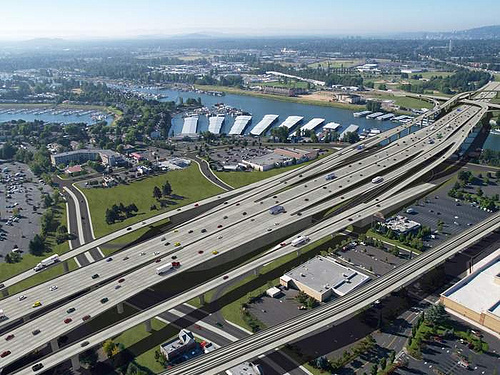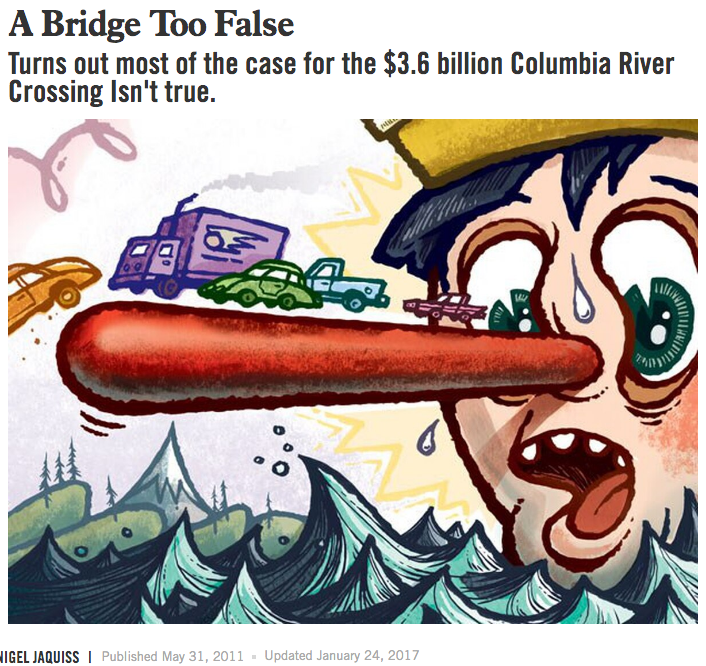State DOT’s are using a false claim about financial liability to revive the Columbia River Crossing folly
There’s no requirement to repay $140 million in federal funds, if states choose the “No-Build” option
The Oregon and Washington department’s of transportation have a scary argument for reviving the failed $3 billion Columbia River Crossing project. They’re telling everyone who will listen, that if we don’t get on with building the bridge by 2025, we’ll have to repay the federal government $140 million. That threat has prompted the two states to revive the bridge.

The argument goes like this. Between 2004 and 2014, the two states spent almost $200 million to plan and engineer the bridge. About 70 percent of that money came from the federal government. But in 2013 and 2014 respectively, Washington and Oregon both walked away from from the project. The two state DOTs are now saying that if you don’t move ahead with the project, you’ll have to repay the federal government $140 million, the federal share of monies that were used to design the project and conduct its environmental impact statement. If we don’t start condemning right of way and turning dirt in five years, we’ll have to pay a $140 million bill.
The DOTs have gotten the media to uncritically parrot this message. The Oregonian’s Andrew Theen reported:
The states now must show considerable progress, including buying up necessary right of way, by the end of September 2024. If the states don’t accomplish that goal, they could owe a collective $140 million to the federal government for planning costs related to the past bridge effort. Oregon’s share is $93.3 million.
Oregon Public Broadcasting’s Dirk Vanderhart said:
. . . lawmakers are also acting with some urgency. As things currently stand, the states have five years to make substantial progress on a bridge, or pay back roughly $140 million in federal funds from the last failed attempt.
Jeff Mize of the Columbian also echoed the talking point:
The Federal Highway Administration previously granted a five-year extension, which means Washington and Oregon would be obligated to repay the $140 million if efforts to replace the bridge were not renewed by Sept. 30.
The threat of having to repay these funds is prompting driving political leaders to pump an additional $44 million into reviving the bridge planning, even though none of the fundamental problems that sank the last effort has been resolved.
Choose the “no build” option; No repayment required
The trouble is, this claim is utterly false: The Federal Highway Administration (FHWA) does not require funds to be repaid, if as part of the environmental review process, the sponsoring agency selects the “No- Build” option.
Here’s how FHWA explains this on their website:
The FHWA does not require repayment of PE funds when project termination is directly related to compliance with another Federal law. For instance, repayment of reimbursed PE costs would not be required if FHWA and a State DOT determine that a project should not be advanced as a result of findings during the National Environmental Policy Act (NEPA) process. To do otherwise could skew the NEPA process by causing a State DOT to favor a “build” alternative to avoid repaying PE costs incurred during the NEPA review.
As the FHWA explanation makes clear, if it required repayment of funds for every project that didn’t go forward, it would undermine the entire purpose of the National Environmental Policy Act. A repayment requirement would be a loaded fiscal gun, forcing states and cities to go ahead with projects that don’t make environmental sense in order to avoid a repayment liability. And that’s exactly what the two State Departments of transportation are trying to convince people of in the case of the CRC; and it’s simply not true.
No one is repaying the $6 million spent on the failed “Salem River Crossing”
Lest anyone doubt that this is the case, consider that this is exactly what is happening the another abortive ODOT bridge building project, the so-called “Salem River Crossing.” Over the past decade ODOT and local governments in the Salem area have spent more than $6 million planning a new bridge across the Willamette River just north of downtown Salem. Just as with the CRC proposal, the project has foundered over community environmental concerns, and problematic and unresolved funding issues. Earlier this year, The Salem City Council formally withdrew its support for the project and instructed ODOT to proceed with the No-Build option. No repayment required:
. . . the City Council on February 11, 2019, voted to send a letter to the Oregon Department of Transportation (ODOT) and the Federal Highway Administration (FHWA) to take no further action on the remaining land use actions needed for ODOT to complete the Final Environmental Impact Statement for a new bridge. As a result of this action, city staff will work with ODOT and FHWA to complete the Salem River Crossing project with No Build as the preferred alternative. The option to do nothing, referred to as the No Build alternative, is always an acceptable option to conclude an Environmental Impact Statement process
And neither Salem nor ODOT is about to repay a dime of the money used for planning and engineering the now dead Salem River Crossing. They don’t have to, because pursuant to Federal regulations, FHWA chose the “No Build” option based on the city and state decisions..
When it comes to the CRC, all that ODOT and the region need to do is select the “No Build” option studied as part of the Columbia River Crossing Environmental Impact Statement process. Doing so would eliminate the liability for repaying the federal government for this effort, which everyone must now acknowledge as a failure.
Once again, the DOTs are lying to try to push the CRC
It may make sense to re-examine the I-5 bridges, and consider a wide range of alternatives. But there’s no reason to have the costs of that failed effort hanging over peoples heads as they consider what to do next. It’s dishonest of the state departments of transportation to tell people there’s a $140 million penalty for not moving forward with this project.

The Columbia River Crossing has a long history of lies. The effort to revive the project shows that its proponents are just as mendacious as ever.
Editor’s Note: This commentary has been revised to correct the dollar amount referred to in the penultimate paragraph, it is $140 million, not $140.


